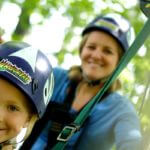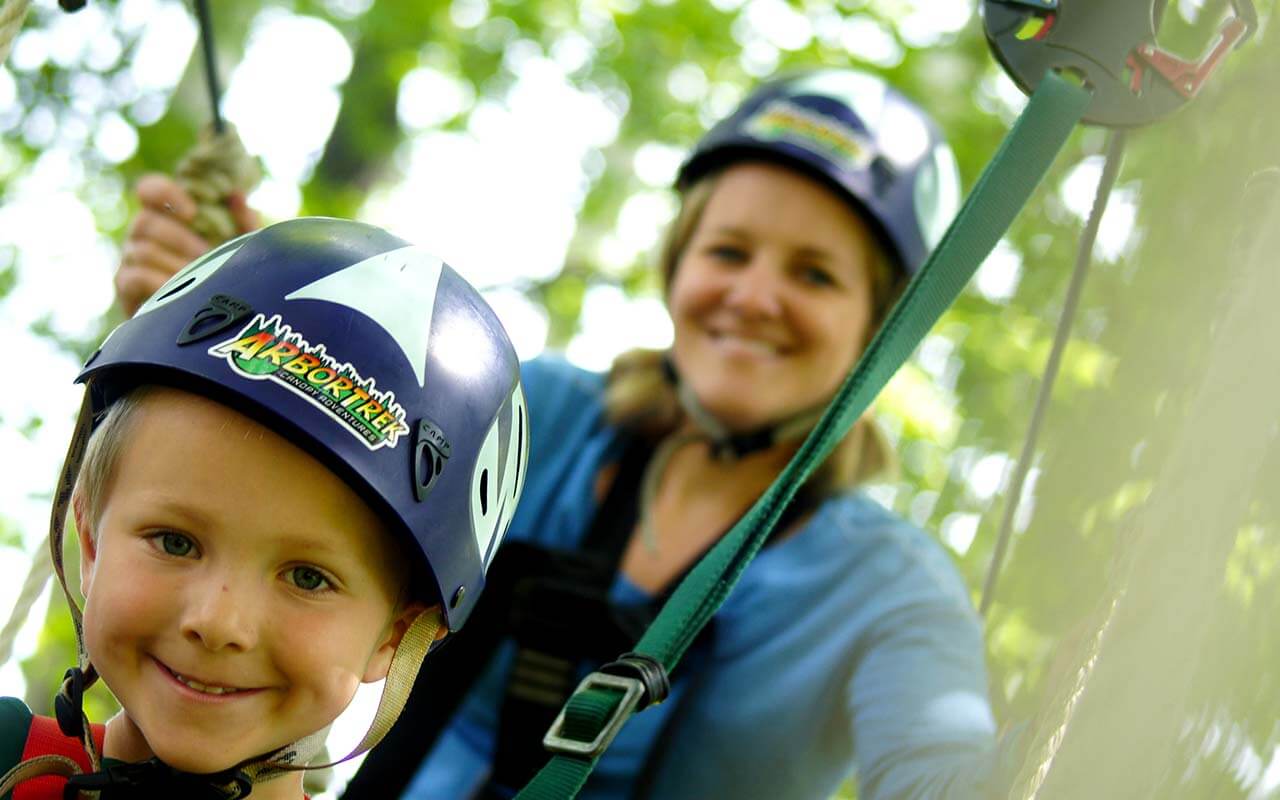Standing along the reed-covered banks of the pond behind our summer house, supervising our young boys in their hunt for bullfrogs, I can’t help but recall fond memories of freshly cut grass and daily excursions into the 20+ acres of woods behind my childhood home. Whether riding bikes along trails with fantastic names like “Devil’s Bend” and “Lion’s Den” or climbing high into the white pines and red maples that were just out of sight of the house, I recall the same sense of freedom and adventure. The woods, like the pond for my kids, were places to study nature, act out heroic adventures, prove oneself to the neighborhood kids, or simply hide and be alone.
I didn’t have a zip line as a child, but my love for climbing trees and exploring wild places stuck with me. It’s a passion that has enveloped my life, leading to a career as a business consultant, builder, and owner/operator in the zip line and aerial adventure park market. With more than 21 years of experience facilitating adventure experiences, building challenge courses, and operating programs that have served more than one million clients, I still find thrilling the anticipation of stepping off the edge of a platform, the snug rise of the harness and the ensuing rush of wind across my face (sadly no longer through my hair), all accompanied by the distinctive buzz of the trolley as I descend the wire rope.
My family and I frequent our parks and, in fact, any park we can find. In the past eight years, I estimate that I have been to more than 400 commercial zip line tours and aerial adventure parks, which may make me one of the most traveled experts in the market. Yet, there is one place I have not zipped—my backyard.
The requests from friends and neighbors (and now my children) to install a zip line in our backyard have become more and more frequent as the popularity of the sport has grown. After all, we have a nice property with appropriately sized and structurally sound trees, a pleasant grade, and access to all of the tools, equipment, materials, and design knowledge needed to build a “world-class” backyard zip line. I tell myself that the project would be fun and that it would draw lots of smiling faces… But that’s where the fantasy ends because the reality of backyard zip lines is that they are wrought with risk.
Over the past year, the frequency of news articles reporting accidents on backyard and temporary zip lines has become all too common. News headlines like “Child accidentally hung from zip line,” “Man falls from zip line lands in critical condition,” “Kid loses hand in zip line accident”, “Zip line accident leaves Aimee Copeland with flesh-eating disease,” and “How to avoid a zip lining disaster” neither bestow the adventure nor the excitement of zip lines. They focus on the realities of the business.
“It ain’t rocket science” is the phrase that often sticks with me when I am called to investigate backyard zip line accidents or read about them in the paper. Further examination of the subject on YouTube might suggest that installing zip lines is, in fact, rocket science and confirms that the number of news articles that make the front page is just the tip of the iceberg. From teens tying a rope to a mattress in their bedroom and jumping out the second-story window (now how did that queen-size mattress fit through that tiny window?) to a smiling bride being run over by an anxious and fast-moving groom, the number of absolutely foolish and sometimes tragic antics that have been recorded and posted are enough to sway my opinion.
The reality is this: ZIP LINES ARE NOT SAFE! ZIP LINES ARE INHERENTLY DANGEROUS!
Aside from the obvious possibilities of structural or component failure, poor design, a fall from heights, collisions with other objects or persons at high speed, environmental incidents, and injuries sustained from attempts to traverse the cable in acrobatic postures or with untested resources, the creativity which end-users seem to employ as a means to up the challenge seems endless. One not need imagine or wonder about firing a handgun at targets during the descent, five riders simultaneously descending a cable designed for one, paint-ballers shooting at the zip rider, jousting, descending a cable attached to a small boat,… the list goes on because they are all available online and the results are often less than intended.
But of course, I know my arguments will not persuade everyone, so the best I can do is educate on what I have learned.
In my experience, the principal causes of backyard zip line accidents appear to be 1) poor or inadequate design and 2) operator error. Let’s take a look at each of these.
I. Building zip lines is not rocket science.
No, building zip lines is not rocket science. Rather, it is physics combined with mechanic and structural engineering, training and development, behavior management, and a little psychology.
Calculating the speeds, forces, and tolerances of a person traveling at a high rate of speed along a wire rope on a trolley is more complex than one might think. Dozens of variables must be accounted for using broad variances (any of which can modify the momentum of the rider at landing by significant amounts), including wind shear, body position of the rider, the mass of the rider, the direction of the wind, speed of the wind, humidity, air temperature, precipitation, properties of the wire rope, type of bearing in the trolley, and so on. These factors are multiplied by the length of the traverse, the slope of the traverse, exposure to elements, type of structures and materials used, variability of weather conditions, and operational procedures.
Most backyard zip lines are purchased as kits with very limited installation instructions. Out of the four kits for which I downloaded installation instructions, the longest set was seven pages and it was labeled “Tips.” In most cases, I found the “tips” dangerously inaccurate. Compare these tips to the current standards that most professional operators make use of when installing commercial zip lines:
- Association for Challenge Course Technology (ACCT), 8th edition
- American National Standards Institute (ANSI)
- ASTM F2959 Standard Practice for Special Requirements for Aerial Adventure Courses
- Occupational Safety and Health Administration (OSHA)
- State Regulatory Policies (defined per state)
These standards are not prescriptive but offer practices developed over many years and often through strict procedures emphasizing involvement and some degree of consensus from impacted parties. As someone who has studied these standards for many years, I will be the first to tell you they require significant background and experience to interpret and understand and are not a replacement for but a supplement to years of field experience coupled with expertise from many fields of study. In fact, they are only a small part of the overall construction standards, which include jurisdictional building codes, workplace safety standards, and manufacturing and design standards from multiple fields of study.
When installing commercial zip lines, most professional vendors undertake lengthy feasibility studies and call upon the expertise of professionals practicing law, surveying, forestry and arboriculture, structural and mechanical engineering (and occasionally civil), training, and information systems. While some individuals might perform all these duties, such individuals are uncommon and evolve only through years of experience, education, and practice.
While many have commented that the design and engineering of a backyard zip line should not require the same due diligence as a commercial operation because the duty of care is different or the complexity is somehow less, I encourage such parties to examine tort law and recent cases. Further, I would suggest that more diligence is required for backyard installations because backyard operators rarely mitigate risks and protect themselves and their users in the same ways commercial operations can protect their assets and users—incorporation, stacked LLCs, participant agreements, liability waivers, general liability insurance, accident medical policies—are uncommon practices for homeowners installing backyard zip lines.
II. Operator Error: Building a Zip Line is the Easiest Part
After many years of operating challenge courses, zip line tours, and adventure parks, I have come to one very strong conclusion… the easiest part of owning a zip line is building it. As I have mentioned above, this is not to say building a zip line properly is easy work. It requires skill, expertise, and a keen sense of self-preservation. Rather, most of the accidents I have investigated have resulted from negligence of the operator or homeowner. To clarify, most accidents resulting from the operator (or owner in the case of a backyard zip line) can be broken down into three root causes:
1) Failure to follow operating procedures or, in the case of a backyard zip line, failure to follow accepted industry standards
This includes
- the failure of anchors or wire ropes commonly due to over-tensioning the wire rope, incorrectly assessing loads on anchors, or improper installation;
- improper use of fall protection and worker restraint systems in applications where the zip line or zip line departure platform is off the ground;
- allowing stunts and acrobatics on the zip descent;
- collision with other riders, spectators, or objects within the corridor;
- lack of rescue equipment or training;
- failure to inspect the system and equipment prior to each use; and
- improper use of the system.
Having trained and managed hundreds of staff, I can attest to the fact that educating guides on accepted practices and operating procedures and ensuring they do not deviate from the agreed-upon procedures is time-consuming and expensive.
Before installing a zip line, homeowners should seek professional training in construction techniques and operating practices. Trained individuals should closely monitor the use of backyard zip lines, and operation should cease immediately if the zip line is not operating properly. When in use, homeowners should enforce procedures regarding the manufacturer’s specified riding posture, positioning, and use of equipment. It is recommended that a professional operator or installer review procedure changes. When not in use, appropriate measures should be applied to restrict access.
2) Exceeds ability/inadequate training
This category includes but is not limited to
- falls from heights due to a failure to use proper worker restraint or fall protection systems during construction or operation,
- failure to adequately supervise use,
- failure to clear the corridor,
- failure to adequately test the system before operation (upon commission, daily, and periodically),
- improper use of equipment,
- failure to stop using the zip line when unsafe conditions exist, and
- lack of rescue equipment or training.
As most backyard zip lines are installed by homeowners armed with only the instructions or “tips” supplied with the kit, accidents are not surprising. As a professional builder and operator, I regularly withness participants exposed to significant risks that could be easily reduced by professional guidance and experience. Such guidance and experience are not found in manuals, on the internet, or over the phone but through professional, on-site consultation. There is little substitute for experience.
3) Failure to properly screen participants/riders
Zip line systems are generally designed with specific tolerances for rider height, weight, and, occasionally, reach to ensure safe operation. Additionally, most operators include restrictions regarding medical concerns, certain types of illness, and sobriety. This category includes a failure to restrict access to participants who:
a) are not within the intended weight limits,
b) lack the physical strength to perform necessary tasks, including proper positioning, self-rescue, and braking (if required),
c) have medical histories, reoccurring or chronic health concerns, or illnesses that place them at higher risk to themselves and others,
d) exhibit behaviors or judgments that place themselves or others at risk and
e) are under the influence of legal or illegal drugs or alcohol that impair judgment.
Many of the backyard kits that I have reviewed (generally ranging from $180 – $500 USD) include disclaimers like “350 lbs. weight limit” or “150 lbs. weight limit”. Such disclaimers are misleading, if not altogether false, because the kits do not specify all of the critical tolerances, nor do they include the tools required to accurately measure variables like the tension of the cable, structural capacities of the anchors (trees, poles, or structures), and proper operating practices. Before operating a zip line, homeowners should carefully detail rider requirements and test their zip line and brake system using water bags, sandbags, or similar weights that do not place a person at risk. Before using the zip line each day, a test ride and visual inspection should be conducted to confirm the zip line is operating as intended. More thorough hands-on or tactile inspections should be conducted at regular intervals.
Core to operating an adventure tour is the mitigation of risk. In the case of commercial zip line operations, risk mitigation includes corporate formation, legal agreements including participant agreements, general liability insurance, worker’s compensation insurance, property insurance, accident medical policies, staff training and development, guide testing, and certification, course inspections (daily, periodic, and professional third-party), detailed local operating procedures, detailed logging, and record keeping, a systematic review of procedures and operations, the development of an experienced management team, timely third-party and professional reviews, review by legal counsel, crisis and emergency action plans, equipment procurement, inspection, and amortization schedules, and so on. To fulfill these requirements, companies must be well-capitalized, and operators must hire talented personnel to develop and enforce policies to protect staff and patrons.
The biggest risk to backyard operators is not simply that the zip line is installed incorrectly (and I have seen some real disasters) but that there is no operating plan or experienced operator present to regularly inspect the zip line to ensure that it is utilized properly when in operation, and that access is restricted when the line is not in use.
I used to receive a lot of calls regarding backyard zip line projects. Some were small projects that I warned might be much bigger than the caller anticipated. Other projects were grossly commercial in scale despite the intended use. I turned away far more projects than I accepted based on one question. “Are you prepared to educate yourself on the industry and accepted practices, carry general liability insurance, commit to professional third-party inspections, receive training and certification as a guide, and enter into an agreement that holds harmless the builder?”
The real question of whether to install a zip line in my backyard is this: “Am I willing and able to provide the same level of care to riders on a zip line in my backyard as I am to the riders who visit my parks?” For me, the answer was very clear. Yes, I could provide the same level of care, but no, I was not willing to because the costs are too great and the risks too high.
This may seem obtuse or cynical, but I think it was arrived by reason. In full disclosure, I do not have a children’s play set either. Instead, my boys and I walk to a local park with an impressive playground, wonderful trees for climbing, and large grassy ball fields good for games or just laying down to watch clouds pass overhead.
For those who choose to forge ahead and install their own zip line in the backyard, I will provide this advice:
- Educate yourself and build within your experience. https://acctinfo.org is a good place to start.
- Seek professional guidance from builders, engineers, and arborists.
- Purchase liability insurance or find other means to protect your assets and those who use your zip line. Don’t assume your homeowner’s policy will cover a zip line. Most will not.
- Build for fun and not for thrills.
- Buy from a professional builder and not a professional seller.
- If the kit comes with instructions or “tips,” follow them carefully. Pay close attention to slope, tension, rider weight limits, and testing requirements. Never test with live riders. User sandbags, water bags, or weights.
Good luck, best wishes, and happy zipping.






